Spatial pattern formation facilitates eradication of infectious diseases
Eisinger, D. and Thulke, H.H., 2008. Spatial pattern formation facilitates eradication of infectious diseases. Journal of Applied Ecology, 45(2), pp.415-423.
It has long been recognized by ecologists that the inclusion of spatial processes is important for accurate model predictions about populations. Until recently, computational power has limited modeling approaches to non-spatial models. This paper examines the importance of including spatial processes in the context of determining threshold vaccination levels required for elimination in a rabies-fox system.
The baseline vaccination threshold for comparison came from a 1980’s a population model based on the classic SIR model. It predicted that vaccinating 70% of the population would be sufficient for large-scale control. Consequently, twenty years of WHO guidelines were prepared following this result. However, some anecdotal evidence suggested that in areas which didn’t quite reach this threshold, rabies elimination had still been achieved.
The authors of this study spent years validating spatial rabies models against observed patterns of the fox rabies epidemic in Europe. Their models could reproduce spatial wave patterns, epidemic and non-epidemic foci of disease transmission, and the effects of spatial vaccine distribution. They presented the confluent model in this paper: a discrete time (one week time steps), spatially explicitly (256×256 cells, each cell is a home range of fox), individual based model for fox rabies parameterized to the rabies epidemic in Europe.
What they found was not all that surprising, given the fact that the inclusion space requires infectious diseases to be more transmissible (higher R0) but still an important applicable result. While their non-spatial model reflected the baseline threshold of vaccination to lead to elimination, their spatial model predicted a threshold of 60% (10% less than baseline). A follow up comparison, using a spatial model without local transmission (individuals could disperse and infect more widely), showed that local transmission was driving the decreased threshold. With more dispersed transmission, the threshold approached that of the non-spatial model. What this means for vaccination programs is that 10% fewer resources could be spent in any one space and those resources could be spread out to more resource limited places.

